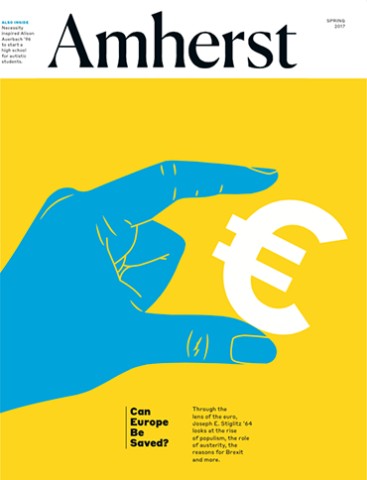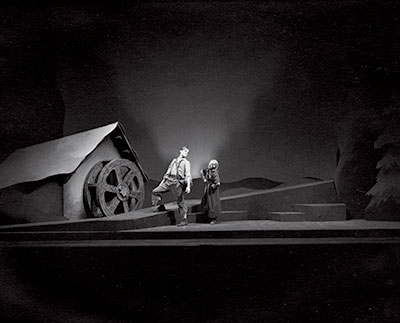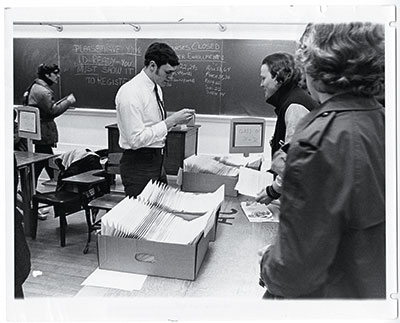Image

She’s Famous

Amy Speace ’90, in your biographic essay, is allowed the claim that she is not famous (“Famous Is Not the Point,” Spring 2017). Amy Speace is not famous?! Ms. Speace’s voice has been coming through my stereo for more than a decade, dating to when WUMB identified itself as folk radio.
There needs to be a rescaling of the criteria for being famous. Donald Trump does not define being famous.
Jon Cole ’67
Arlington, Mass.
Mammoth Opinions
OK, Mammoth it is, and will be—unless we find some skeleton in its closet (First Words, Spring 2017). But wait, that already happened, so good to go.
So, Mammoth it will be, and once was—if we can wrap our heads around that oddity. Good thing longtime Amherst Professor Henry Steele Commager already tried, citing Jefferson: “It may be asked why I insert the mammoth, as if it still existed. I ask in return why I should omit it, as if it did not exist.”
Fletcher M. Burton ’78
Nashville
I will dutifully root for the Amherst Mammoths, but I must ask: why didn’t the small but feisty Hamsters make the finals? Perhaps the Mascot Committee, like the British officials who rejected “Boaty McBoatface,” feared hamsters lack a certain gravitas. With all due respect, a mascot is an adult in a foam rubber costume, leading cheers and jeers while our team tries to get a ball over a line (or through a hoop, or into a net) more times than our rivals, the Purple Cows. How much gravitas is warranted?
Debbie Steinig ’94
Baltimore
It’s a little disheartening that a college that has produced presidents, statesmen, authors, philanthropists, visionaries, artists and poets (and especially visionaries, artists and poets!) should adopt a mascot better suited to a T-ball team for 6-to-8-year-olds. Nothing against the individual(s) who submitted the name: they were just having some fun. But it’s easy to picture members of the Mascot Committee dithering about at their meetings, playing Minecraft on mobile devices, when they were expected to be doing something meaningful for Amherst’s future. And for the record, I was fully in favor of ditching Lord Jeff.
Trevor Dennie ’90
Tacoma, Wash.
You cover well the details as they relate to the “process” of determining a new mascot name to replace Lord Jeffery (College Row, Spring 2017). However, you do not make any mention of the reason(s) for discarding the longstanding and dear mascot name. Certainly, this was not done on a whim.
As I recall, it started with a relatively small group of students who had concerns over the lifestyle of Lord Jeffery Amherst. How sad that a small group can influence such a far-reaching decision to “bag” old Lord Jeffery! A sign of our times, I guess, where a small number can so dramatically sway decisions relating to a significant change.
To me, the sports teams will always be the Jeffs and my association with my fair college will always be a loyalty to Amherst—yes, Lord Jeffery that is.
James D. Brayer ’55
Fairport, N.Y.
Editor’s note: Of the 5,974 alumni who responded to a December 2015 poll, 52 percent felt unfavorably about Lord Jeff as the unofficial mascot, while 38 percent felt favorably and 10 percent had no opinion or were unsure. In November 2015, 89 percent of the student body took part in a student government poll that asked, “Do you think Lord Jeffery Amherst should be removed as our unofficial mascot?” Of those, 83 percent answered yes and 17 percent answered no. For more background, go to amherst.edu/mascot.
In the profiles of new courses (Winter 2017), we learned that there is no “ideal voting system”; rather, all have “drawbacks.” Professor Tanya Leise apparently refers to Kenneth Arrow’s “Impossibility Theorem”: essentially, no voting system can unerringly convert individual voter rankings of multiple candidates into a resulting groupwide preference.
She identified the “instant run-off” system as having such “drawbacks.” In voting theory, there are two principal “fairness criteria”—the “Majority Criterion” (a majority of voters prefers the winner) and the “Condorcet Criterion” (the winner is preferred head-to-head against each other candidate). The “winner” in an “instant run-off” vote might not satisfy either.
Ironically, the College held an “instant run-off” vote to select among five mascot finalists—and sure enough, 75 percent of voters preferred a mascot other than the eventual “winner,” Mammoths.
Voters ranked their mascot preferences from first to fifth. If there was no majority winner based on first-place votes, there were to be “instant run-offs” based on second-place and lower votes until a “winner” emerged.
Mammoths garnered fewer than 25 percent of the first-place votes (2,189), losing head-to-head to Purple and White (2,314)—thus failing to satisfy the Condorcet Criterion. And even counting the second-place and lower votes, Mammoths garnered support on only 4,356 of the 9,104 valid ballots—thus failing to satisfy the Majority Criterion, but finally nosing out Purple & White (4,134).
Yet, we are now Mammoths.
College mascots usually are adopted by tradition, shared over generations, as symbols of good luck and expressions of unity. “Instant run-off” voting is no substitute for tradition.
Although the announced rules were followed to reach a decision, the vote revealed neither unity nor strong sentiment for the “winner.” Whether students, athletic teams and alumni embrace Mammoths will only be known in due time.
Craig C. Reilly ’76
Alexandria, Va.
Professor Leise responds: Arrow’s Theorem offers up the bad news that no reasonably consistent and fair system exists for aggregating individuals’ preferences into an overall ranked ordering. That’s not to say all systems are equally problematic. Compared to plurality voting, ranked-choice (instant run-off) more fully expresses preferences and diminishes spoilers and vote splitting. While it lacks some desirable mathematical properties (as Arrow’s Theorem says it must), problems caused by these may arise relatively rarely in practice.
Did ranked-choice voting provide a reasonable outcome in the mascot election? In the first round, Purple & White had the most votes, followed closely by Mammoths, a near tie. Under the plurality system, a voter who preferred an animal mascot would have had to choose among Mammoths, Hawks and Wolves, which together garnered 54 percent of first-place votes, splitting that block’s votes (with Wolves a potential spoiler).
It was indeed a close vote. However, the set of voters (48 percent) preferring Mammoths over Purple & White (the top two in all rounds, and never widely separated from one another) had a sufficient margin to be a clear outcome. The ranked-choice ballot was effective in this tight election, providing information about voters’ relative ranking of options, reducing vote splitting and wasted votes, and identifying a winner that a near-majority preferred over the next most viable option.
The Stories Behind the Photos


The registration photo in the Winter 2017 issue brought back memories of the “Problems of Inquiry” course, held in Fayerweather,that Andy von Salis ’75 signed up for freshman year: “As I filed into that big, creaky all-wood theatre with its tall windows for its first class at noon, already hungry for lunch, I was handed a heavy stack—at least six inches thick—of Xeroxed papers. I asked, ‘Oh, should I hand these out?’ How embarrassing! Those were my printouts of the supplemental required readings. I blanched, shrank and found a seat near the back. The senior faculty lecturer spoke in wonderfully scholarly and impenetrable long sentences, of which I recall nothing but one frequently recurring key phrase. At the end of 50 minutes, we filed out in silence, most of us probably feeling as humbled as I was, and heading toward Valentine. My remark to those within earshot seemed to lighten things up: ‘Well, I’m starved, as it were.’”
Correction
The Spring 2017 College Row story on La Causa history incorrectly stated that the Plan de San Diego encompassed parts of California and Mexico. It actually encompassed parts of Texas and Mexico.
Social Media Posts

Judy Collins: “Happy to speak about the wonderful Amy Speace for Amherst College Magazine!”
Olive Street House Concerts (Pittsburg, Kan.): “Lots of really wonderful musicians have crossed our stage. Most are just passing through and the interactions are always cordial, but sometimes there’s a greater connection. Amy Speace is one of those cases where it just feels like extended family is visiting when she comes around. Her alma mater recently wrote a nice profile piece about her that we wanted to share. And we’ll be glad to welcome her back in December for our holiday show.”